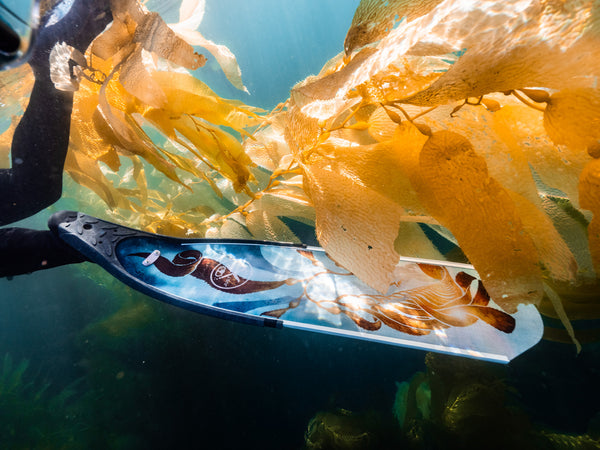BEHIND THE NEW DIVER FIN COLLABORATION

Jessie Kendall-Bar is one of the most talented individuals we've come across in our neck of the woods. She is an award-winning scientist, artist, and science communicator with publications of her work in The New York Times and The Atlantic, and she was exactly who we wanted to collabobrate with in designing a new set of custom DiveR freediving fins.
We are so pleased with the way that they came out and had to get out in the water with her to see them in action in the kelp. She was kind enough to do an interview with us and give us a glimpse into the inspiration behind the fin design. Keep reading for the full interview and Youtube video!
Delaney, JGW: Where are you from and how does that affect your work?
Jessica Kendall-Bar: "I grew up all over California, in San Francisco, Santa Cruz, Palo Alto, Santa Monica, Berkeley, and San Diego – so, California’s kelp forests make me feel like I’m home. Santa Cruz was where I fell in love with the ocean - we had a little cabin in the Santa Cruz redwoods we would go to every weekend when I lived in Palo Alto. I got into marine biology in high school when I did water quality testing near LA’s biggest storm drains. I studied Marine Science and Integrative Biology at UC Berkeley, then got my PhD in Ecology and Evolutionary Biology at UC Santa Cruz on how seals sleep at sea. Currently, I am a postdoctoral researcher at UC San Diego studying diving physiology of penguins, seals, whales, and even human freedivers."
JGW: How did you get into art and design? Do you have any artistic influences?
JKB: "The two artistic media that are most fun for me are woodburning and animation. I woodburned in high school for the first time and fell in love with the way it required patience, precision, and steadiness - it is very meditative. I appreciate interacting with the organic wood material and enjoying the odors of wood from different trees – maple is the sweetest. Animation and digital art were something I got into a little later, through a course at CSU Monterey Bay with their Science Illustration Program. I liked the ability to merge art with where I spend most of my time at work – the computer – and it is such a fun way to infuse art, creativity, and infinite possibilities to data and science that is often inaccessible."
JGW: How do you think art and design is important to ocean conservation and is influential to conversations about the environment?
JKB: "I think art can bring hidden ecosystems closer to our hearts and minds. By seeing our impact on ecosystems through data visualizations, animations, or illustrations, we can better imagine the impacts of our actions, both positive and negative."
JGW: How did the collaboration of the DiveR fins with Just Get Wet materialize and where did you find inspiration for the design?
JKB: "I’ve always searched for a good pair of kelp forest fins, but haven’t quite found the right pair. I pitched the idea of designing some to Chris at Just Get Wet, and he was in! I was so excited to see this design travel from my sketchpad to iPad to strands of carbon fiber, all the way to the kelp forests in Point Loma. The design shows a woman’s shadow as she ascends, wrapped in the growing apical meristem of a giant kelp. The blades of the kelp split the white light of the sun into a rainbow that dances on the floor – just like in the actual kelp forest. The woman has an octopus wrapped around her arm, her companion as she navigates the underwater forest."
JGW: If you could transform into any animal, what would it be and why?
JKB: "If I could transform into any animal, I would definitely want to be a harbor seal. They lollygag in the kelp, wrap themselves in it and take a nap below the waves, under a rock, come find diver friends, and make their day. I studied northern elephant seals for my dissertation, who have a bit more extreme lifestyle of traveling halfway to Japan and back navigating predators in the open ocean. That life is not for me. I choose the life of a harbor seal basking in kelp-created rainbows in the shallows."






